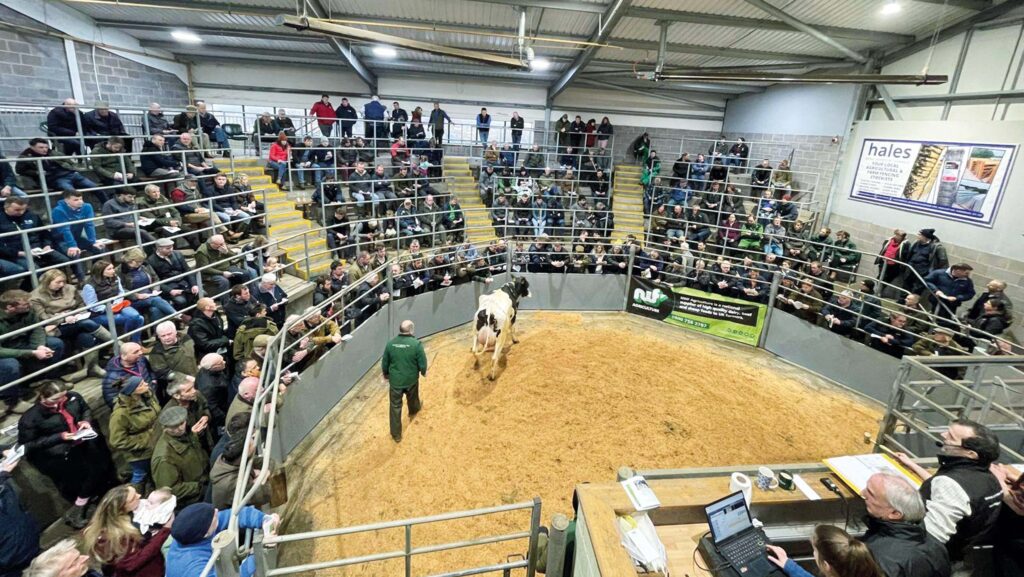Dairy cows sell for record highs as milk prices hold firm
 Frankton Hall herd sale © Shrewsbury Auction Centre
Frankton Hall herd sale © Shrewsbury Auction Centre Dairy cows have been making a tremendous trade at sales so far this year as milk markets look to be holding into February and March.
Holstein Friesian-cross cows under 36 months averaged more than £2,200/head at sales across the country in the past week, up by almost £600/head on the same week last year.
At a dispersal sale at Shrewsbury Auction Centre on 28 January, 101 in-milk cows averaged more than £2,500/head, while heifers averaged £2,554/head.
See also: Saputo Dairy serves notice to more than a dozen producers
A top price of £3,500 was achieved on the day, with a further 29 cattle hitting more than £3,000/head.
Halls auctioneer Jonny Dymond said: “A total of 44 successful buyers travelled from across England and Wales to fuel what I believe is a record average for a commercial herd of dairy cows anywhere the UK.”
Last month, a collective sale at Sedgemoor saw a similar flying trade, with 21 calved cows averaging an unprecedented £2,742/head.
Meanwhile, at Market Drayton on 29 January, fresh heifers levelled at £2,258 apiece and cows averaged just above £2,000/head.
The numbers
- 2,200 Holstein Friesian-cross cows under 36 months average (£)
- 3.7 Lift in values (%) at Global Dairy Trade auction on 4 February
- 1.1 Estimated increase (%) in GB milk production during 2025
Milk price holds
Milk processors Arla, Muller, Barbers, and First Milk have all held farmgate prices well above 40p/litre as markets remain hesitant.
Mike Smith, vice-chairman at First Milk, said: “We have seen softening in some of the dairy markets, however, with our business performing in line with expectations, we are pleased be able to provide continued stability in our milk price.”
UK wholesale cream and butter prices dropped marginally during January, partially due to unfavourable exchange rates, and spot milk prices were recently quoted at as low as 35p/litre.
However, there are some signs of hope for producers on the horizon, with overall trade at the fortnightly Global Dairy Trade auction on 4 February up by 3.7% on the previous auction.
Nick Holt-Martyn, principal consultant at the Dairy Group, says EU butter prices have stabilised and are staging a recovery after a New Year slump.
He said: “Milk supply is still positive, but is accompanied with positive demand that is providing the firmness to the market.”
GB daily deliveries have continued to trend roughly 3% higher on the year during January, and the AHDB forecast that overall milk production is to increase by 1.1% during 2025.
Market outlook
The AHDB has also forecast that milk prices will remain firm in the short term, but may start to decrease towards the second half of the year.
Susie Stannard, lead dairy analyst at AHDB, said: “After a tough start to the season, the industry is showing signs of recovery.
“Higher milk prices and a stronger milk-to-feed ratio are encouraging farmers to boost production.
“We’re seeing solid growth, but we must also be mindful of global risks, from fluctuating commodity prices to disease outbreaks, which could disrupt this upward trajectory.”
Ms Stannard added: “Cheese demand will continue to rise, supported by promotions and the popularity of home-cooked meals.
“Butter consumption may decrease due to price competition with plant-based alternatives, while yogurt sales are expected to grow, driven by health trends.
“The dairy sector has demonstrated resilience in the face of significant challenges.
“However, the industry’s ability to navigate these uncertainties will depend on how well it can balance production increases with fluctuating demand and external pressures.”
